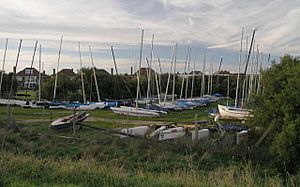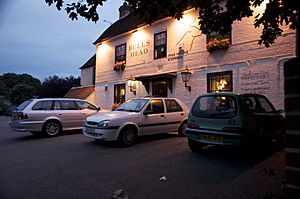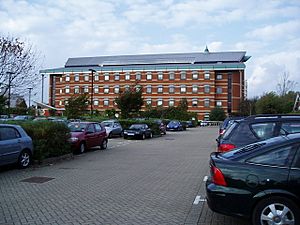Goring-by-Sea facts for kids
Quick facts for kids Goring-by-sea |
|
|---|---|
 The yacht club, 2006 |
|
| Population | 7,990 (2011. Goring Ward) |
| OS grid reference | TQ111025 |
| District | |
| Shire county | |
| Region | |
| Country | England |
| Sovereign state | United Kingdom |
| Post town | WORTHING |
| Postcode district | BN12 |
| Dialling code | 01903 |
| Police | Sussex |
| Fire | West Sussex |
| Ambulance | South East Coast |
| EU Parliament | South East England |
| UK Parliament |
|
Goring-by-Sea, often called just Goring, is a neighborhood in Worthing, West Sussex, England. It used to be a separate village but is now part of the larger town. Goring is located west of West Worthing, about 2.5 miles (4 km) west of Worthing's town center. It has been part of the borough of Worthing since 1929.
Contents
What's in a Name? The Meaning of Goring
The name Goring probably means 'Gāra's people' or 'people of the wedge-shaped strip of land'. The 'by-Sea' part was added to help people tell it apart from another village called Goring-on-Thames in Oxfordshire.
Goring's Past: A Look at Its History
Around the 6th century, Goring became part of the kingdom of Sussex. Like other villages in southern Sussex, the people of Goring used land further north in the Weald (a wooded area) as summer pastures for their animals. This route was likely used to move livestock, especially pigs.
Goring was already a recognized area during the Domesday Book survey in 1086, where it was called Garinges. Unlike other nearby areas, Goring was part of the 'Rape of Arundel'. A 'Rape' was an old way of dividing up the county of Sussex, named after a castle and its town. Goring used to have four main 'manors' (large estates). The most important of these changed hands many times over the years.
Castle Goring, a large country house built in the late 1790s for Sir Bysshe Shelley, 1st Baronet, is located in the former Goring parish. People started building homes in Goring in the 1800s, and this continued through the 1900s. Even though the railway arrived in Goring in 1846, not many people used the station at first, so it even closed for a while!
Goring's population grew a lot after 1929 when it became part of Worthing. It grew even more in 1938 when the railway lines were made electric. Over about 50 years, much of the old village of Goring was taken down, but a few historic buildings still remain. Just before 1939, the Goring Hall area was planned like a 'garden city', with curved streets near the sea.
Goring's Landscape: Beaches and Green Spaces
Goring has a beach made of both pebbles and sand. It's a popular spot for many watersports, like kitesurfing. In the southwest part of Goring, there's an area called the Goring Gap. This is a protected space with fields and woods between Goring and Ferring, keeping the area green and open.
The old village of Goring is in the southern part of the former parish. To the northeast is the Maybridge estate. North of Maybridge is West Durrington. Further north and west of West Durrington, you'll find Castle Goring, Titnore Wood, and the eastern side of Highdown Hill, which includes the beautiful Highdown Gardens.
Important Places: Landmarks in Goring
St Mary's Church is the local Anglican church. It was first built around 1100 AD and was rebuilt in 1837.
The Bull's Head pub on Goring Street has been a pub since at least 1770. It might even be the same pub that was closed down in the early 1600s by strict local officials called Justices of the Peace.
Courtlands is another historic building, built in the 1820s. It was made bigger between 1906 and 1910.
Goring Hall, built around 1889, is a copy of an earlier building from the 1840s. The original was likely designed by Charles Barry, who is famous for helping to rebuild the Palace of Westminster in London. Today, Goring Hall is a hospital. A path lined with holm oak trees, planted in the 1840s, leads from Goring Hall to St Mary's Church.
The English Martyrs' Catholic Church has a very special feature: a hand-painted copy of the Sistine Chapel ceiling! It was painted by Gary Bevans between 1987 and 1993.
Durrington Bridge House is a large red-brick building near Durrington-on-Sea station. It's an office for HM Revenue and Customs (the UK tax department) and has 900 employees. This building is expected to be replaced with homes in the future as the offices will move to Worthing town center.
Learning in Goring: Schools and Colleges
St Oscar Romero Catholic School on Goring Street is a secondary school for both boys and girls that opened in the 1950s. Goring Church of England Primary School is the main primary school for younger children in the area.
Just outside Goring, but still within its former parish boundaries, is Northbrook College's West Durrington campus. This site is also known as University Centre Worthing and has been part of Greater Brighton Metropolitan College since 2017. It offers both further education (like college courses) and higher education (like university degrees).
Getting Around: Transport in Goring
The A259 road runs through Goring from east to west. This road connects Goring to Worthing and Brighton in the east, and to Littlehampton and Bognor Regis in the west. The A2032 Littlehampton Road also runs east–west, just north of Goring.
Goring has two railway stations: Goring-by-Sea railway station in the west, which opened in 1846, and Durrington-on-Sea railway station in the east, which opened in 1937. Both stations are on the West Coastway Line and provide train services to Worthing, Brighton, Littlehampton, London, and Southampton.
Famous Faces: Notable People from Goring
- George Saxby Penfold was a vicar (a type of church leader) in Goring from 1815 to 1832.
- George Brooke-Pechell was a Royal Navy officer and a Member of Parliament (MP) for Brighton from 1835 to 1860. An MP is a person elected to represent a group of people in the government.
- Keith Emerson, a famous keyboard player and songwriter, grew up in the Maybridge estate in Goring.
- Francesca Hayward is a talented ballet dancer.
- Billy Idol is a well-known musician.
- Richard Jefferies was a nature writer.
- David Lyon was a merchant and a Member of Parliament for Bere Alston in Devon.
- John Molson was a Canadian-born Member of Parliament for Gainsborough in Lincolnshire.
- Arthur Somerset Sr was a cricketer who played for Sussex and London teams between 1891 and 1906.
- Frederick Claude Stern was a botanist (someone who studies plants) and horticulturalist (someone who grows plants).
Images for kids







